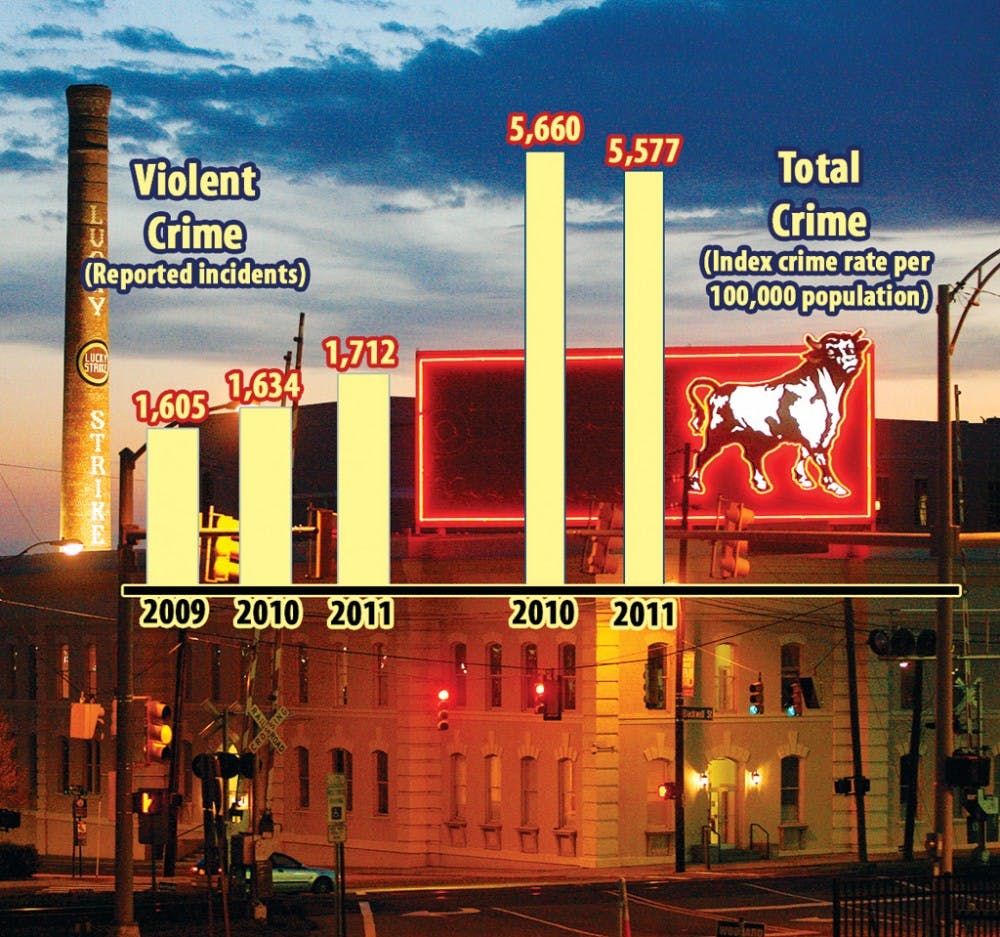Violent crime rates spiked in the Bull City, despite a downward trend in the city’s total crime from 2010 to 2012.
According to the Durham Police Department’s annual report, total crime diminished from 2010 to 2012 by more than 1 percent. Property crime, which includes burglary, larceny and vehicle theft, dropped by 2 percent to 11,263 incidents, while violent crime, which consists of homicide, rape, robbery and aggravated assault, jumped by nearly 5 percent to 1,712 incidents.
The total crime rate marks the lowest rate Durham has seen in a decade, said DPD Chief Jose Lopez. Over the past decade, Durham’s violent crime rate per 100,000 people decreased by 25 percent, and the property crime rate dropped by 31 percent. Last year’s total crime figures are in line with this trajectory, Lopez added.
“Our department has followed a community policing philosophy for many years,” he said. “The partnerships established over the years have created positive change in our community.”
Lopez said the increase in violent crime is tied to the way in which crimes are reported. Any instance in which victims could have been harmed is recorded as violent crime. He added that this may explain why the 2012 rate bucked the 10-year downward trend.
“If a man shot a single bullet at a school bus, and there were 23 passengers, that would be recorded as 23 counts of aggravated assault,” Lopez said. “But if the same man were to commit a murder in cold blood, that would only be one count of a violent crime—homicide—even though the same number of shots were fired.”
Doubts about safety
In some ways, the University is isolated from broader Durham trends.
Duke students are involved in very few violent crimes, said John Dailey, chief of the Duke University Police Department.
“Violent crime on the Duke campus is very low,” Dailey noted. “DUPD works closely with University departments, students and DPD to understand and address students’ safety concerns.”
An area approximately 3 miles east of East Campus has one of Durham’s highest concentrations of gun violence incidents, according to the DPD’s annual report. In response to this frequency, DPD initiated Operation Bull’s Eye, a project that works to crack down on gun violence in that two square mile area, in 2007.
Violent gun crimes dropped by more than 51 percent in the target area from 2007 to 2012, according to the report.
The ethnically diverse nature of Durham may give the city a reputation of high crime among students, said freshman Derek Rhodes, Duke Student Government senator for Durham and regional affairs.
“I’ve never considered Durham to be an unsafe place,” said Rhodes, who has lived in Durham for his entire life. “But no one area of town is similar to another, which contributes to some people feeling unsafe or out of place in certain areas. Students should feel safe interacting with Durham.”
Students who live off campus are afforded the same safety measures as on-campus residents, Rhodes added. The University ensures that students living in popular off-campus locations have access to the same resources, such as DUPD, as those living on campus.
“One of our most important tasks is ensuring that students feel safe, especially concerning off-campus housing,” he said.
Some students reported mixed feelings about their safety while interacting with Durham.
Freshman Harli Grant said she feels relatively safe, even when alone, while walking around East Campus.
“I come from a very safe area, so potential dangers don’t really occur to me,” Grant said. “Perhaps it’s unfounded, but I feel safe in Durham.”
But freshman Kelsey Sturman said she only feels comfortable traveling with large groups that include men, adding that she feels a general sense of paranoia and fear when walking near East Campus after sundown.
“I rarely notice a police car stationed near East Campus at night, which makes me uncomfortable,” she said. “I would feel safer if I noticed more patrol cars in the area.”
Community outreach
The best way to continue mitigating violent crime is to encourage involvement and participation in law enforcement by Durham’s community members, said Lt. Patrice Vickers, executive officer to the DPD police chief. She added that DPD offers several programs to educate the general public on safety and safety awareness.
In 2012, DPD launched the Residential Awareness Program—an initiative that seeks to cut down burglaries—and the Hispanic-Latino Outreach Campaign—a program that was created to enhance the relationships between Latino crime victims and DPD officers.
“These are priceless practices that can be taken with you wherever you go,” Vickers said. “The community is one of the largest components to the crime reduction strategy. Our goal is to empower this community. We are making great strides in doing just that.”
Duke Student Government is also taking measures to ensure safety on campus. The Durham and regional affairs committee actively evaluates safety measures for Duke students on and off campus, said junior Alexandra Swain, DSG vice president for Durham and regional affairs. She noted the Duke Vans Services, help phone stations and campus lighting as major projects that her committee seeks to improve.
Swain added that she noticed Durham becoming safer as she grew up.
“I would consider Durham to be the safest that it has been,” said Swain, a Durham native. “Duke students in particular need to take precautions when going off campus because our location is centralized. I don’t see Durham as much different than any other campus that has a city.”
Get The Chronicle straight to your inbox
Signup for our weekly newsletter. Cancel at any time.

